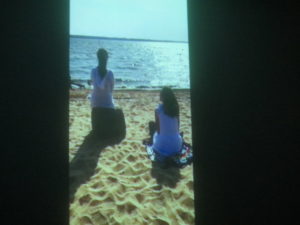
By Prof. Carmen Sanchis-Sinisterra
Many years ago I saw a play that changed my relationship to theater; it was a rupturist staging of La vida es sueño, a 17th-century masterpiece by Pedro Calderón de la Barca. It touched some place very deep in me and, since that day, theater is one of the art forms that I admire the most. Why then—I often wonder—do I fail to include theater in my syllabi? This semester, inspired by my colleague Prof. Christina Baker and with her precious help, I decided to introduce and experiment with embodied pedagogies in the classroom. In our course devoted to literary criticism, HISP 208, students creatively and critically engaged with the famous play by Croatian-Chilean author Sergio Vodanović, El delantal blanco (1956). What follows is the explanation of the project by three of my students in their own words:
“El delantal blanco was a thought-provoking play that we read for my Literary Criticism course in Hispanic Studies,” says freshman Joel Calfee (’20). “The play focused on a woman and her maid spending the day at the beach, and the work explored themes of social class and gender roles. However, what made this play even more interesting was that our class explored it in a deeper fashion by breaking into groups and performing it in front of the camera. We were instructed to act out sections of the play, while having one director film it and add any personal touches that seemed necessary. Once all of the projects were completed, we watched them as a class, and it was very interesting to see everyone interpreting the lines uniquely. This project showed us that written works can be absorbed by students in so many distinct ways.”

The challenge of performing scenes from El delantal blanco led students to constantly revisit the script and explore meanings that otherwise may be lost in a simple, quick reading of the print version. “Although at first I stumbled through the words and awkwardly moved in front of the camera, I gradually became more comfortable,” adds Ashlynn Sommers (’20). “By the end, I realized that through the process of filming I was able to better understand the play and it made me more confident in my Spanish-speaking abilities.”
The performances offered by students were far from a simple, mechanical enactment of Vodanović’s play. Rather, it was a collaborative enterprise that allowed students to creatively craft meaning beyond the literal words of the script. Caroline Nutter (’18) explains this creative process as follows: “We decided to drive to the beach to film our portion (the play is set on a beach), and the other actress and I decided to switch characters halfway through because I fit the role of one character better than she did. It is encountering these artistic problems, and finding creative ways to solve them, that made this project so enjoyable.
Surprisingly, my students forget to mention the performance of a scene of El delantal blanco that Professor Baker and I did for them in front of the class—i.e., live! We certainly have not; practicing our lines, trying out costumes, and choosing props transformed that particular class into a special event in which, via embodied practices that led from page to stage to screen, students accessed and generated layers of meaning that would otherwise be elusive or lost in a print text.

